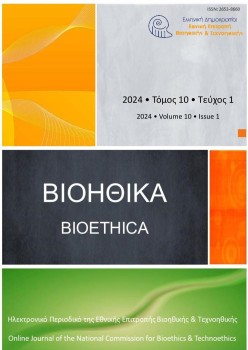Το ανθρώπινο πρόσωπο και το μετανθρώπινο όραμα: Θεολογική προσέγγιση
Resumen
Η επιθυμία του ανθρώπου για μετεξέλιξή του σε ένα ον πιο προικισμένο προκειμένου να καλυτερεύσει τους όρους της ζωής του δεν είναι νέα, αλλά σύμφυτη με το είδος του. Αρωγοί στην πορεία του φιλοσοφία και θρησκεία, προσπαθώντας να δώσουν λύσεις στο διακαές αίτημα βελτίωσης της ανθρώπινης φύσης, από τη δική της θέση έκαστη. Φτάνοντας στην εποχή της Ύστερης -ή Ρευστής- Νεωτερικότητας ο άνθρωπος επιτυγχάνει να σπάσει τα δεσμά της παράδοσης, και στηριζόμενος στις δικές του δυνάμεις προωθεί το μοντέλο του ελεύθερου, αυτεξούσιου ανθρώπου.
Στην εποχή της αλματώδους προόδου της Επιστήμης και της Τεχνολογίας, ο άνθρωπος επαναπροσδιορίζει την ταυτότητά του ως πρόσωπο και τη συνολική του σχέση με τον Θεό και το περιβάλλον. Παράλληλα, ο ολιστικός μετασχηματισμός των δομικών στοιχείων που αποτέλεσαν τα θεμέλια της νεωτερικότητας συνιστά χαρακτηριστικό της μετάβασης σε μια μετα-μοντέρνα εποχή, δημιουργώντας νέα ταυτότητα για τον άνθρωπο, αυτή του μετα-ανθρώπου, ο οποίος δεν αποτελεί πλέον ένα ουτοπιστικό όραμα, παρά δρομολογείται μέσω του Διανθρωπισμού και των διεπαφών.
Στο πλαίσιο των νέων κοινωνικών μετασχηματισμών υπό το πρίσμα της τεχνολογικής προόδου, δημιουργείται προβληματισμός σχετικός με τη δυνατότητα διατήρησης της ταυτότητας του ανθρώπινου είδους ως «πρόσωπο» με τα χαρακτηριστικά του όντος-θεϊκού δημιουργήματος, βάσει της Πατερικής Διδασκαλίας, ή αν τελικά μετασχηματιστεί σε ναρκισσιστική, παντοδύναμη και αυτονομημένη ύπαρξη, απομακρυσμένη από την ανθρωπιά της.
Article Details
- Cómo citar
-
Δουραμάνη Γ. (2024). Το ανθρώπινο πρόσωπο και το μετανθρώπινο όραμα: Θεολογική προσέγγιση. Bioethica, 10(1), 24–46. https://doi.org/10.12681/bioeth.37388
- Sección
- Original Articles

Esta obra está bajo una licencia internacional Creative Commons Atribución 4.0.
Authors who publish with this journal agree to the following terms:
- Authors retain copyright and grant the journal right of first publication with the work simultaneously licensed under a Creative Commons Attribution CC BY 4.0 License, which allows for immediate free access to the work and permits any user to read, download, copy, distribute, print, search, or link to the full texts of articles, crawl them for indexing, pass them as data to software, or use them for any other lawful purpose. Appropriate credit must be given by citing the author(s) and the original publication in this journal.
- Authors are able to enter into separate, additional contractual arrangements for the non-exclusive distribution of the journal's published version of the work (e.g. post it to an institutional repository or publish it in a book), with an acknowledgement of its initial publication in this journal.
We encourage authors to deposit their articles, as well as data underlying the publications, in institutional and/or other appropriate subject repositories.
Bioethica permits and encourages authors to archive the final publication pdf in institutional (e.g. the repository of the National Hellenic Research Foundation) or other appropriate subject repositories (e.g. SSOAR repository for social sciences), in compliance with institutional and/or funder open access policies, after publication in the BIOETHICA. Authors must provide bibliographic details that credit publication in the journal, as well as related funding details (when applicable).
Lists of institutional and other subject-based academic open access repositories can be found listed by country at the registry http://opendoar.org/countrylist.php
If your institution does not possess a repository you may deposit a copy of your paper at no cost with www.zenodo.org , the repository supported for open access research in the EU by the European Commission, through the project OpenAIRE (www.openaire.eu )



